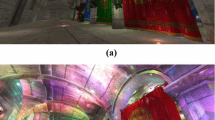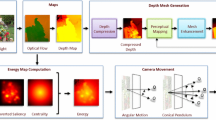Abstract
Photic extremum lines (PELs) are view-dependent, object-space feature lines that characterize the significant changes of surface illumination. Though very effective for conveying 3D shapes, PELs are computationally expensive due to the heavy involvement of the third- and fourth-order derivatives. Also, they require the user to manually place a few auxiliary lights to depict the model details, which is usually tedious work. To overcome these challenges, we present a novel computational framework that improves both the speed and quality of PELs. First, we derive a simple, closed-form formula of gradient operator such that various orders of derivatives can be computed efficiently and in parallel using graphics processing units (GPUs). The GPU-based PEL extraction algorithm is one order of magnitude faster than the original one. Second, we propose to extract PELs from various non-photorealistic shadings that not only depict the overall shape but also bring out the details at different frequencies simultaneously. As a result, the user can easily control the relative emphasis to different scales and obtain the desired line drawing results. We demonstrate the improved PELs on a wide range of real-world objects.
Similar content being viewed by others
References
Buchanan, J.W., Sousa, M.C.: The edge buffer: a data structure for easy silhouette rendering. In: NPAR ’00, pp. 39–42. ACM, New York (2000)
Canny, J.: A computational approach to edge detection. IEEE Trans. Pattern Anal. Mach. Intell. 8, 679–698 (1986)
Cole, F., Golovinskiy, A., Limpaecher, A., Barros, H.S., Finkelstein, A., Funkhouser, T., Rusinkiewicz, S.: Where do people draw lines? ACM Trans. Graph. 27(3) (2008)
DeCarlo, D., Rusinkiewicz, S.: Highlight lines for conveying shape. In: Proceedings of NPAR, pp. 63–70 (2007)
DeCarlo, D., Finkelstein, A., Rusinkiewicz, S., Santella, A.: Suggestive contours for conveying shape. In: Proceedings of ACM SIGGRAPH, pp. 848–855 (2003)
Gooch, B., Sloan, P.J., Gooch, A., Shirley, P., Riesenfeld, R.F.: Interactive technical illustration. In: Proceedings of ACM Symposium on Interactive 3D Graphics, pp. 31–38 (1999)
Hertzmann, A., Zorin, D.: Illustrating smooth surfaces. In: Proceedings of ACM SIGGRAPH, pp. 517–526 (2000)
Judd, T., Durand, F., Adelson, E.: Apparent ridges for line drawing. In: Proceedings of ACM SIGGRAPH (2007)
Kalogerakis, E., Nowrouzezahrai, D., Simari, P., McCrae, J., Hertzmann, A., Singh, K.: Data-driven curvature for real-time line drawing of dynamic scene. ACM Trans. Graph. 28(1) (2009)
Kolomenkin, M., Shimshoni, I., Tal, A.: Demarcating curves for shape illustration. ACM Trans. Graph. 27(5) (2008)
Kolomenkin, M., Shimshoni, I., Tal, A.: On edge detection on surfaces. In: CVPR’09, pp. 2767–2774 (2009)
Lee, C.H., Hao, X., Varshney, A.: Geometry-dependent lighting. IEEE Trans. Vis. Comput. Graph. 12(2), 197–207 (2006)
Lee, Y., Markosian, L., Lee, S., Hughes, J.F.: Line drawings via abstracted shading. ACM Trans. Graph. 26(3), 18 (2007)
Maciejewski, R., Isenberg, T., Andrews, W.M., Ebert, D.S., Sousa, M.C., Chen, W.: Measuring stipple aesthetics in hand-drawn and computer-generated images. IEEE Comput. Graph. Appl. 28(2), 62–74 (2008)
Ni, A., Jeong, K., Lee, S., Markosian, L.: Multi-scale line drawings from 3D meshes. In: Proceedings of ACM Symposium on I3D, pp. 133–137 (2006)
Ohtake, Y., Belyaev, A., Seidel, H.: Ridge-valley lines on meshes via implicit surface fitting. In: Proceedings of ACM SIGGRAPH, pp. 609–612 (2004)
Raskar, R., Tan, K.H., Feris, R., Yu, J., Turk, M.: Non-photorealistic camera: depth edge detection and stylized rendering using multi-flash imaging. In: SIGGRAPH Course Notes (2005)
Rusinkiewicz, S., Burns, M., DeCarlo, D.: Exaggerated shading for depicting shape and detail. ACM Trans. Graph. 25(3), 1199–1205 (2006)
Rusinkiewicz, S., Cole, F., DeCarlo, D., Finkelstein, A.: Line drawings from 3D models. In: SIGGRAPH Course Notes (2008)
Saito, T., Takahashi, T.: Comprehensible rendering of 3D shapes. Proc. ACM SIGGRAPH 24(4), 197–206 (1990)
Vergne, R., Pacanowski, R., Barla, P., Granier, X., Schlick, C.: Light warping for enhanced surface depiction. ACM Trans. Graph. 28(3) (2009)
Winnemöller, H., Olsen, S.C., Gooch, B.: Real-time video abstraction. ACM Trans. Graph. 25(3), 1221–1226 (2006)
Xie, X., He, Y., Tian, F., Seah, H.S., Gu, X., Qin, H.: An effective illustrative visualization framework based on photic extremum lines (PELs). IEEE Trans. Vis. Comput. Graph. 13(6), 1328–1335 (2007)
Zhang, L., He, Y., Xie, X., Chen, W.: Laplacian lines for real-time shape illustration. In: Proceedings of ACM Symposium on Interactive 3D Graphics and Games (I3D ’09), pp. 129–136 (2009)
Author information
Authors and Affiliations
Corresponding author
Additional information
This work has been supported by the National Research Foundation grant, which is administered by the Media Development Programme Office, MDA (IDMPO). Ying He is partially supported by AcRF 69/07. Long Zhang is partially supported by NSFC 60903085 and an Open Project Program of the State Key Lab of CAD&CG (A0905).
Rights and permissions
About this article
Cite this article
Zhang, L., He, Y. & Seah, HS. Real-time computation of photic extremum lines (PELs). Vis Comput 26, 399–407 (2010). https://doi.org/10.1007/s00371-010-0454-x
Published:
Issue Date:
DOI: https://doi.org/10.1007/s00371-010-0454-x




